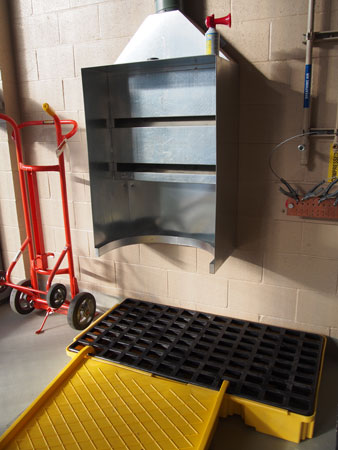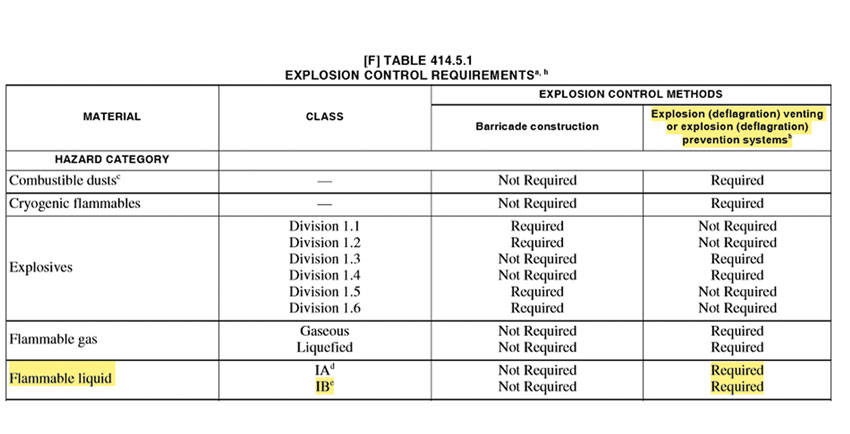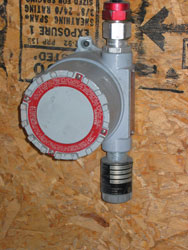Take a thoughtful path for designing the flammables area at an HHW facility, an important and often missed step during design.
By David Nightingale, CHMM, S.C.
As mentioned in part two of this series (Waste Advantage Magazine, February 2020), the International Building Code®(IBC®) typically would consider the area where flammable liquids are stored and consolidated into drums, as a high-hazard, H-2 occupancy. This occupancy designation drives a lot of code requirements and increases HHW collection facility construction costs when compared to most other building types.
Last time we dug into some of the ventilation requirements for H-2 occupancies where flammable liquids are consolidated. The cost of ventilation equipment operating in an area where flammable vapors exist is significant, but necessary for safety where flammable liquids are consolidated. There are additional code requirements in H occupancies for prevention or venting of explosions, installation of explosion-proof electrical equipment and wiring, static electricity bonding and grounding, more robust fire suppression systems, secondary containment of spills and fire suppression water, and other features that each add to the cost of HHW facilities. Figure 1 shows a flammable liquid consolidation workstation with a spill pallet, ventilation hood, static electricity bonding cables and breathable supplied-air line.

Flammable liquids consolidation workstation at Elk Grove, CA.
Photos courtesy of Special Waste Associates.
Mixed-Use Occupancies
Fortunately, the IBC® allows what is called mixed-use occupancies—buildings with multiple occupancy designations under one roof. Using mixed-use occupancy designations provides a method to contain the cost of the expensive H occupancy areas at HHW facilities. This is typically accomplished by limiting the flammable liquid processing and storage activities to a separate walled-off area of the building and designating only that area of the building as an H occupancy. These H occupancy areas of HHW facilities require fire rated separation from other occupancies—usually using fire barriers with two-hour fire-resistance rating construction.
Other waste handling and storage areas are commonly designated as an S occupancy, and office, restrooms and non-waste areas are often designated as B occupancies. This mixed-use occupancy approach is not leveraged by all HHW facility designers. This often results in the full suite of the more costly H occupancy features being required throughout those HHW buildings. So, the natural follow-up question is “How much of the HHW collection facility is typically needed for the flammable liquid processing and storage?”
Sizing Flammable Liquids Areas
A first step in evaluating the space needs for flammable liquid processing and storage is to examine your collection program’s typical HHW waste stream volumes. Some judgement must be applied to discern which HHW categories are likely to be flammable liquids. Gasoline, white gas, turpentine, toluene, acetone, methyl ethyl ketone (MEK), and many petroleum-based fuels and solvents are clearly flammable liquids according to the IBC® and are shipped using that Department of Transportation classification. Oil-based (alkyd) paints, varnishes and stains straddle the line between the IBC® classifications of flammable and combustible liquids depending on their specific flash point temperature, so it is prudent to assume that they are flammable liquids. On the other hand, latex paints are clearly not flammable liquids, and neither are acids, bases, anti-freeze, used oils, and paint related materials such as caulking and spackle.
More complicated are certain pesticides, such as malathion, which is formulated with flammable liquid carriers. A quick look at some malathion safety data sheets from different manufacturers show contents including 12 percent xylene and a range of about 15 to 30 percent naphtha—all flammable liquids. One manufacturer lists malathion’s flash point as 108º F, while another lists it as 155º F, and a third manufacture as 100º F. At a flash point of 100º F, you are crossing from combustible to flammable liquids categories in the IBC®. So, selected liquid pesticides may be prudently stored in the flammable liquids storage area of your HHW facility.
Generally, you may have anywhere from 25 up to 50 percent of HHW materials awaiting shipment classified as flammable liquids. HHW proportions vary significantly between communities. An exception to this range of flammable liquids is where an HHW facility is co-located with an MSW energy recovery facility. At those locations most of the high energy-value flammable liquids can be used to boost the energy output, usually excluding pesticides. In those cases, the proportion of flammable liquids to the total quantity of HHW to be shipped offsite may be closer to 10 percent or less.
The size of the H occupancy is also dependent on which flammable liquids are consolidated before storage. Some operators only consolidate the lighter, more volatile fuels and solvents, but not oil-based paints. This is especially common in states with paint product stewardship programs. So, the space needed to store the flammable liquids needs to account for these differences in packaging.

Managing Explosion Potential in Flammable Liquids Areas
In addition to the requirements for fire-resistance separation between occupancies, explosion venting or explosion prevention in the H occupancy is typically required where flammable liquids are consolidated. This requirement is shown in the excerpt from the 2018 IBC® Table 414.5.11 (see Figure 2). Class IB flammable liquids such as gasoline, toluene, acetone and isopropyl alcohol are commonly delivered to HHW collection facilities and, thereby, invoke the need for explosion control. Explosion venting (pressure relief systems) construction is often more expensive than providing explosion prevention methods such as flammable/combustible gas monitoring instrumentation and alarms. However, it is not uncommon to see both systems together at HHW facilities, which adds safety.

Typical combustible gas sensor at Product Care Recycling, British Columbia.
The explosion prevention method is required at HHW collection facilities that consolidate flammable liquids in Washington State. Specifically, “an explosive gas monitoring alarm system must be implemented” to assure that flammable vapors “do not exceed ten percent of the lower explosive limit in the area”.2 This example state environmental permitting requirement is consistent with the National Fire Protection Association’s Standard 69 regarding explosion prevention systems. Standard 69 is directly referenced at section 911.1 of the International Fire Code® in areas where flammable liquids are consolidated. Figure 3 shows a typical combustible gas detection sensor, which is wired to a monitoring and alarm system to provide explosion prevention.
A Thoughtful Path
The main takeaways here are:
• You should thoughtfully consider how large to make the H-2 occupancy for processing and storing flammable liquids based on waste stream proportions and processing choices mentioned previously
• That area should be physically separated from the rest of the building using fire-resistant construction to save capital construction cost in the other occupancy areas
• Where flammable liquids are consolidated, explosion prevention, explosion venting or both should be part of the design
The examples above illustrate a thoughtful path for designing the flammables area at an HHW facility that is often missed during design. However, this brief article is not comprehensive regarding design for flammable liquids areas. In designing or upgrading your facility, use design professionals who can examine the full suite of applicable codes and consult with your local fire and building officials and state permitting authorities early and often to assure that you satisfy all of their requirements. | WA
The next issue’s column will focus on weather protection.
Household hazardous waste (HHW) demands special attention because it represents the most toxic fraction of the municipal solid waste stream. Proper HHW management encompasses a special set of safety, training, design, and policy issues that are separate and apart from other solid waste programs. HHW Corner delves into these unique issues starting with this six-part series devoted to improving the state of practice for the design of HHW collection facilities. Feel free to contact the author regarding suggestions for HHW Corner topics that you may like to see covered in future editions of Waste Advantage Magazine.
David Nightingale, CHMM, S.C., is Principal at Special Waste Associates (Olympia, WA), a company that assists communities in developing or improving HHW and VSQG collection infrastructure and operations. They have visited more than 140 operating HHW collection facilities in North America. As a specialty consulting firm, Special Waste Associates works directly for program sponsors providing independent design review for new or upgrading facilities—from concept through final drawings to create safer, more efficient and cost-effective collection infrastructures. Special Waste Associates also published the book, HHW Collection Facility Design Guide. David can be contacted at (360) 491-2190, e-mail c[email protected] or visit www.specialwasteassoc.com.
Notes
Excerpt of Table 414.5.1 from the 2018 International Building Code; Copyright 2017; Washington, D.C.: International Code Council. Reproduced with permission. All rights reserved. www.ICCSAFE.org.
Washington Administrative Code 173-350-360(6)(a)(iv)(K).
You may als0 like:
